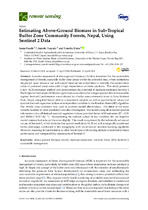| dc.contributor.author | Pandit, Santa | |
| dc.contributor.author | Tsuyuki, Satoshi | |
| dc.contributor.author | Dube, Timothy | |
| dc.date.accessioned | 2018-05-15T11:52:18Z | |
| dc.date.available | 2018-05-15T11:52:18Z | |
| dc.date.issued | 2018 | |
| dc.identifier.citation | Pandit, S. et al. (2018). Estimating above-ground biomass in sub-tropical buffer zone community Forests, Nepal, using Sentinel 2 data. Remote Sensing, 10: 601 | en_US |
| dc.identifier.issn | 2072-4292 | |
| dc.identifier.uri | http://dx.doi.org/10.3390/rs10040601 | |
| dc.identifier.uri | http://hdl.handle.net/10566/3672 | |
| dc.description.abstract | Accurate assessment of above-ground biomass (AGB) is important for the sustainable
management of forests, especially buffer zone (areas within the protected area, where restrictions
are placed upon resource use and special measure are undertaken to intensify the conservation
value of protected area) areas with a high dependence on forest products. This study presents
a new AGB estimation method and demonstrates the potential of medium-resolution Sentinel-2
Multi-Spectral Instrument (MSI) data application as an alternative to hyperspectral data in inaccessible
regions. Sentinel-2 performance was evaluated for a buffer zone community forest in Parsa National
Park, Nepal, using field-based AGB as a dependent variable, as well as spectral band values and
spectral-derived vegetation indices as independent variables in the Random Forest (RF) algorithm.
The 10-fold cross-validation was used to evaluate model effectiveness. The effect of the input
variable number on AGB prediction was also investigated. The model using all extracted spectral
information plus all derived spectral vegetation indices provided better AGB estimates (R2 = 0.81
and RMSE = 25.57 t ha-1). Incorporating the optimal subset of key variables did not improve
model variance but reduced the error slightly. This result is explained by the technically-advanced
nature of Sentinel-2, which includes fine spatial resolution (10, 20 m) and strategically-positioned
bands (red-edge), conducted in flat topography with an advanced machine learning algorithm.
However, assessing its transferability to other forest types with varying altitude would enable future
performance and interpretability assessments of Sentinel-2. | en_US |
| dc.language.iso | en | en_US |
| dc.publisher | MDPI | en_US |
| dc.subject | Above-ground biomass (AGB) | en_US |
| dc.subject | Medium-resolution | en_US |
| dc.subject | Random forest (RF) | en_US |
| dc.subject | Sentinel-2 | en_US |
| dc.subject | Sustainable management | en_US |
| dc.title | Estimating above-ground biomass in sub-tropical buffer zone community Forests, Nepal, using Sentinel 2 data | en_US |
| dc.type | Article | en_US |
| dc.privacy.showsubmitter | FALSE | |
| dc.status.ispeerreviewed | TRUE | |
| dc.status.ispeerreviewed | © 2018 by the authors. Licensee MDPI, Basel, Switzerland. This article is an open access
article distributed under the terms and conditions of the Creative Commons Attribution
(CC BY) license (http://creativecommons.org/licenses/by/4.0/). | |

